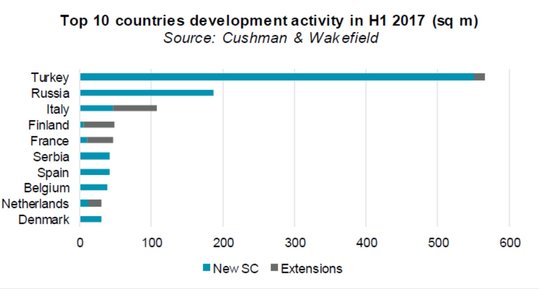- Total floorspace in Europe reaches 160.8 million sq m at midpoint of the year – driven by CEE
- 34 new centres and 21 extensions added 1.2million sq m in H1 2017, with Turkey accounting for nearly half of all new space
- A further 6.8 million sq m is set to be completed across H2 2017-2018
Shopping centre development activity in the first half of 2017 increased total floorspace across Europe to 160.8 million sq m at the midpoint of the year, according to Cushman & Wakefield.
In the first half of the year 825,000 sq m was delivered to the market in Central & Eastern Europe (CEE), compared with 344,000 sq m in Western Europe – although Western Europe still accounts for more than two-thirds (68%) of total built shopping centre space. In total, 34 new shopping centre projects were completed (representing 84% of new space added in H1), while 21 existing schemes were extended.
Turkey was by far the most active market, accounting for 48% (566,000 sq m) of all new European shopping centre space, followed by Russia with 186,000 sq m and Italy with 107,000 sq m of new space.
The half-yearly total added was 11% lower than the same period in 2016, with development activity affected by growing competition, changing consumer behaviour, and the growth of online retailing. A further 6.8 million sq m of space is currently under construction and expected to be completed by the end of 2018.
Silvia Jodlowski, report author, Cushman & Wakefield, said: “Shopping centres are going through a period of significant transition as retail evolves. The focus now is more on creating an appealing, inspiring and experiential environment for the customer, which cannot be wholly replicated online. Landlords are responding by extending and redeveloping existing schemes and creating diverse tenant mixes based on the needs of local communities. Many schemes have introduced more socially-focused services and new technologies, while occupiers continue to test new concepts and formats.”
Justin Taylor, Head of EMEA Retail, Cushman & Wakefield, said: “A great example of retail’s enduring transformational power is Westgate Oxford in the UK which is the largest opening in Western Europe this year. In place of the tired original 1970s centre are four distinct buildings, each designed by a different architect capitalising on the city’s architectural heritage. Westgate Oxford is introducing some of the world’s biggest brands to Oxford. A rooftop dining area with destination restaurants looking across the city and providing public events space, providing a compelling food and beverage offer that is now simply not optional. It is a similar story with The Lexicon Bracknell, the UK’s other major opening of the year, which has reinvigorated the town centre and put Bracknell on the map as a retail and leisure destination.”
Western Europe
Total floorspace was 109.1million sq m at the half year point. Despite limited development activity in Western Europe’s three largest shopping centre markets – UK, France and Germany – activity in Southern Europe remained buoyant. Italy was the most active development market, adding more than 100,000 sq m of new space – more than 30% of Western Europe’s total in H1 2017.
Although shopping centre density is already high in the Nordics, strong population growth in metropolitan areas and improved consumer spending support the further development taking place. More than 500,000 sq m is under construction and due to be completed by the end of 2018, of which approximately 40% will be in the capital cities.
Central & Eastern Europe
Istanbul, which has the highest levels of development activity in Europe, accounted for 35% of the new space added in Turkey. Development activity in Turkey is expected to remain buoyant, despite a softening in occupational demand.
Russia’s 1.7milliom sq m pipeline for H2 2017 – 2018 is the strongest in Europe, representing about a quarter of total space. Moscow only accounts for 13% of the Russian pipeline, as development strengthens in more remote Russian regions such as Vladivostok, Khabarovsk and Grozny.
While development activity in Poland was limited in H1 2017, it has a strong pipeline with 600,000 sq m of space under construction. Nearly a third of this space is in Warsaw, where higher-than-average levels of provision have not discouraged further development.
Małgorzata Dziubińska, Associate Director, Consulting and Research, Cushman & Wakefield, Poland, said: “A number of large and medium-sized schemes were delivered to the market in H2 2017 following the relatively subdued shopping centre development in the first six months. Key openings in the second half of the year include Galeria Północna in Warsaw (64,000 sq m of GLA), Wroclavia in Wrocław (64,000 sq m of GLA) and Serenada in Krakow (42,000 sq m of GLA). As a result of the delivery of such modern and large-scale projects to markets with relatively high shopping centre density, older retail schemes will have to reinvent themselves, leading to redevelopment and refurbishment of floorspace and expansion of F&B and leisure offers.”



















